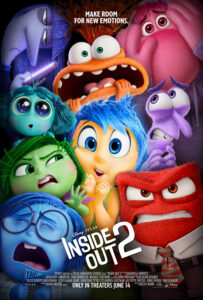The older we get, the more experiences and emotions we have to process. It’s a simple fact of life, though the feelings are anything but simple.
That’s one of the key themes of “Inside Out 2,” the recently released sequel to the Oscar-winning 2015 film “Inside Out,” both from Disney and Pixar Studios. Like the first film, “Inside Out 2” gives viewers a glimpse inside the mind of Riley Anderson, a young girl learning to deal with internal and external life changes that often feel way beyond her control.
In the original, Riley moves with her parents from Minnesota to San Francisco, and her emotions (depicted as characters in the “headquarters” of Riley’s mind) — Joy, Fear, Anger, Disgust and Sadness — work together, though not without conflict, to help her navigate the challenges of integrating into a new school, house and city.
That film focuses on the idea of “core memories,” and one of the film’s chief takeaways is that our memories are colored by a combination of emotions. For instance, a sad memory of a hurtful experience is also colored by joy in that someone we love offered comfort in the midst of our pain.
New emotions
In “Inside Out 2,” Riley’s core memories have built her “core beliefs,” chief among them that she is a good person. In an effort to preserve this belief and protect Riley, Joy sends good memories into long-term storage and trashes Riley’s bad memories: “We keep the best and toss the rest,” Joy says.
But as Riley enters puberty, four new emotions — Envy, Embarrassment, Ennui and, most prominently, Anxiety — enter headquarters and begin to vie for control as Riley looks ahead to high school.
There are no villains in this film. Joy and Anxiety have different strategies for helping Riley cope, but they both have her best interests at heart. Anxiety wants to make things happen, but it leads to paralysis if left in control. Joy wants to suppress Riley’s pain, but Riley must learn to deal with all her mistakes and all the feelings that result from them.
In the end, Riley realizes the contradictions we all carry as humans: “I’m selfish. I’m kind. I’m not good enough! I’m a good person. I need to fit in. But I want to be myself! I’m brave. But I get scared.”
Though not a faith-based film, “Inside Out 2” opens the door for parents to have gospel-focused conversations with their children:
- What does it mean to be a “good person”?
- How does Scripture help us form our core beliefs?
- How can we recognize and cope with anxiety?
- How does our faith inform how we pursue our personal goals and relate to others?
- How does the Bible teach us to address sin and its consequences?
“Inside Out 2” is also family-friendly, though younger children might have trouble following the complexities of the plot.
Trusting God with our feelings
 In “Not Finished Yet,” a young girl named Wren paints with her grandmother. Sometimes they paint what they see, but often they paint what they feel: “She and Gran called it ‘painting prayers.’”
In “Not Finished Yet,” a young girl named Wren paints with her grandmother. Sometimes they paint what they see, but often they paint what they feel: “She and Gran called it ‘painting prayers.’”
As Wren paints her “Dear God” squiqqle, she recalls experiences that made her feel embarrassed, frustrated, sad, jealous, angry, happy and thankful. Gran reminds Wren that she can talk to God about all of her feelings — the joyful ones and the painful ones — because she matters to Him. Wren discovers what we all need to remember: God welcomes our honest prayers.
In the author’s notes at the end of the book, Brown offers some thoughts on prayers of lament and provides several questions for adults and young readers to discuss after reading the book.
“Prayers of lament are a way to practice hope,” Brown writes. “Though we may not understand the why behind our pain, … when we seek God when we are hurting, we place our hope in His goodness.”
Adult readers will enjoy the book’s story and illustrations as much as children, and Brown’s gentle call to spend time with God in prayer is a good reminder for us all.
Brown is the author of several spiritual formation novels for adults, including “Sensible Shoes” and “Shades of Light.” Find her books at InterVarsity Press or wherever books are sold.






Share with others: